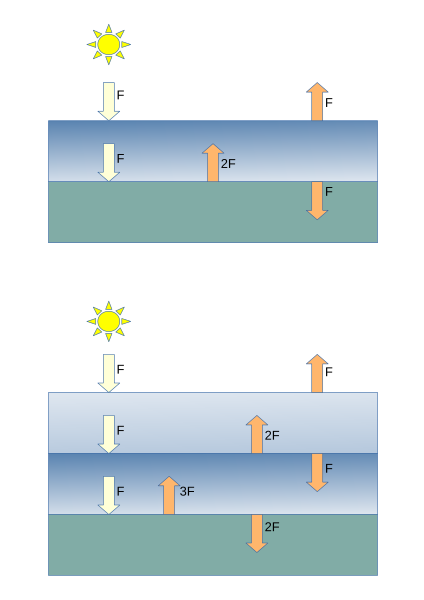File:Model of a planet with atmosphere.svg

Original file (SVG file, nominally 744 × 1,052 pixels, file size: 35 KB)
Captions
Captions
Summary edit
| DescriptionModel of a planet with atmosphere.svg |
English: Considering an atmosphere composed of a single isothermal layer. Because the layer is
opaque in the longwave part of the spectrum, the equivalent blackbody temperature of the planet corresponds to the temperature of the atmosphere. Hence, the atmosphere must emit F units radiation to space as a blackbody to balance the F units of incoming solar radiation transmitted downward through the top of the atmosphere. Because the layer is isothermal, it also emits F units of radiation in the downward direction. Hence, the downward radiation at the surface of the planet is F units of incident solar radiation plus F units of longwave radiation emitted from the atmosphere, a total of 2F units, which must be balanced by an upward emission of 2F units of longwave radiation from the surface. Hence, from the Stefan–Boltzmann law the temperature of the surface of the planet is 303 K, i.e., 48 K higher than it would be in the absence of an atmosphere. If a second isothermal, opaque layer is added, as illustrated below the flux density of downward radiation incident upon the lower layer will be 2F. (F units of solar radiation plus F units of longwave radiation emitted by the upper layer). To balance the incident radiation, the lower layer must emit 2F units of longwave radiation. Because the layer is isothermal, it also emits 2F units of radiation in the downward radiation. Hence, the downward radiation at the surface of the planet is F units of incident solar radiation plus 2F units of longwave radiation emitted from the atmosphere, a total of 3F units, which must be balanced by an upward emission of 3F units of longwave radiation from the surface. By induction, the aforementioned analysis can be extended to an N-layer atmosphere. The emissions from the atmospheric layers, working downward from the top, are F, 2F, 3F . . . NF and the corresponding radiative equilibrium temperatures are 303, 335 . . . . [(N 1)F/σ]1/4 K. The figures used to generate this plot and text were obtained from Wallace, John M. og Hobbs, Peter V. (2006): Atmospheric Science – An Introductory Survey (second edition.), page 121-122. Elsevier. ISBN 978-0-12-732951-2. |
| Date | |
| Source | Own work |
| Author | Frankemann |
Licensing edit
- You are free:
- to share – to copy, distribute and transmit the work
- to remix – to adapt the work
- Under the following conditions:
- attribution – You must give appropriate credit, provide a link to the license, and indicate if changes were made. You may do so in any reasonable manner, but not in any way that suggests the licensor endorses you or your use.
- share alike – If you remix, transform, or build upon the material, you must distribute your contributions under the same or compatible license as the original.
File history
Click on a date/time to view the file as it appeared at that time.
| Date/Time | Thumbnail | Dimensions | User | Comment | |
|---|---|---|---|---|---|
| current | 16:55, 13 May 2019 |  | 744 × 1,052 (35 KB) | Frankemann (talk | contribs) | Enlarged illustration |
| 16:37, 13 May 2019 |  | 744 × 1,052 (35 KB) | Frankemann (talk | contribs) | User created page with UploadWizard |
You cannot overwrite this file.
File usage on Commons
There are no pages that use this file.
File usage on other wikis
The following other wikis use this file:
- Usage on no.wikipedia.org
Metadata
This file contains additional information such as Exif metadata which may have been added by the digital camera, scanner, or software program used to create or digitize it. If the file has been modified from its original state, some details such as the timestamp may not fully reflect those of the original file. The timestamp is only as accurate as the clock in the camera, and it may be completely wrong.
| Width | 210mm |
|---|---|
| Height | 297mm |